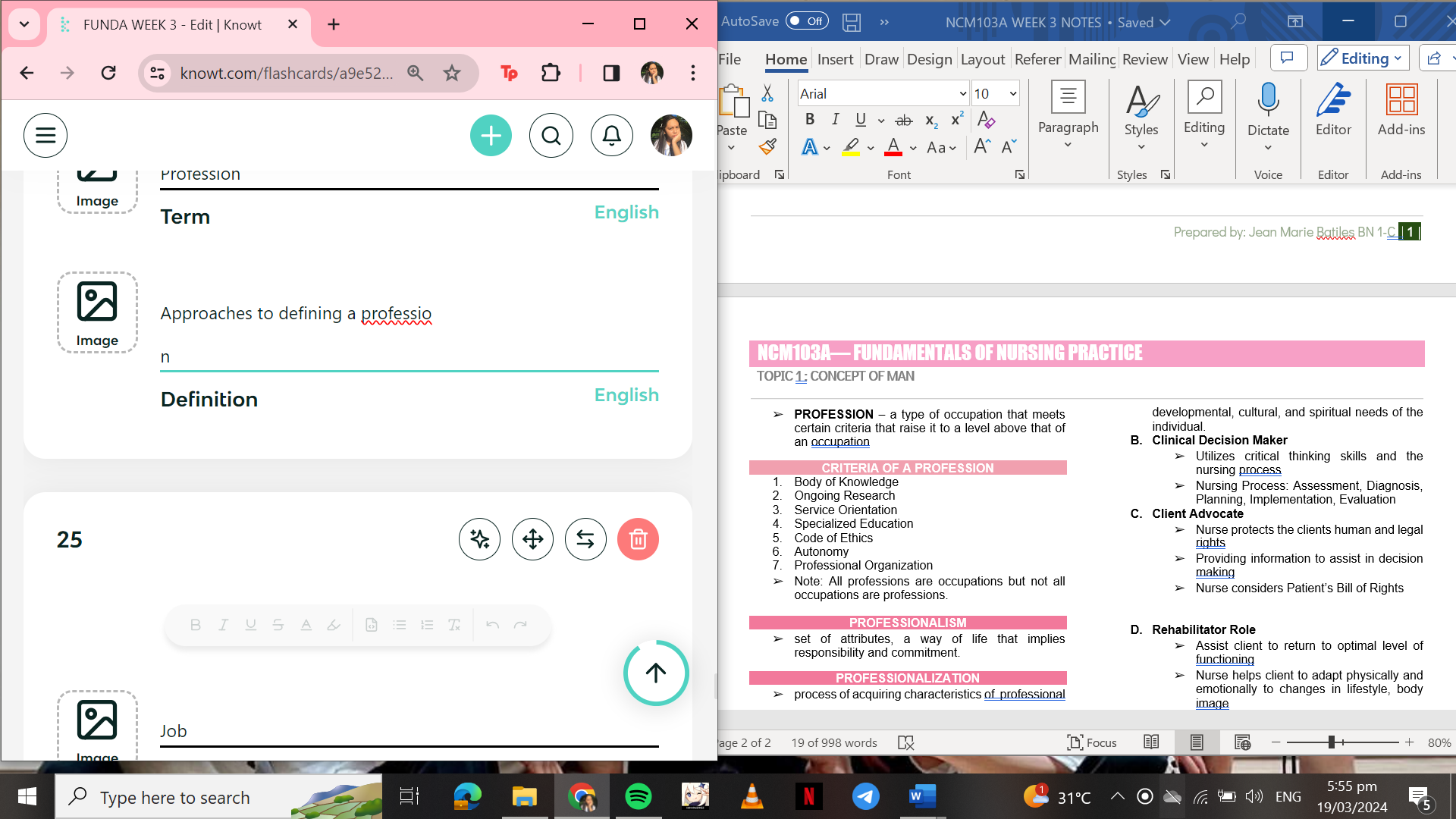FUNDA WEEK 3
1/37
There's no tags or description
Looks like no tags are added yet.
Name | Mastery | Learn | Test | Matching | Spaced |
|---|
No study sessions yet.
38 Terms
FACTORS AFFECTING HEALTH AND ILLNESS (WHO)
Social and Economic environment
Physical environment
Person’s Individual Characteristics and Behaviors
Social Determinants of Health
Income and Social status
Education
Social Support Networks
Culture
Health Services
Physical Environment
Safe water and clean air
Employment and working conditions
Person’s Individual Characteristics
Genetics
Personal Behavior and coping skills
Gender
Income and Social Status
higher income and social status are linked to better health.
Education
low education levels are linked with poor health, more stress and lower self-confidence.
Social Support Networks
greater support from families, friends and communities is linked to better health.
Culture
customs and traditions, and the beliefs of the family and community all affect health.
Health Services
access and use of services that prevent and treat disease influences health.
Safe water and clean air
healthy workplaces, safe houses, communities and roads all contribute to good health
Employment and Working Conditions
people in employment are healthier, particularly those who have more control over their working conditions.
Gender
men and women suffer from different types of diseases at different ages
Stages of Health-Seeking Behavior by IGUN
➢ Stage 1 : Symptom Experiences
➢ Stage 2 : Self-treatment or Self-medication
➢ Stage 3 : Communication to Others
➢ Stage 4 : Assessment of Symptoms
➢ Stage 5 : Sick-role Assumption
➢ Stage 6 : Concern
➢ Stage 7 : Efficacy of treatment
➢ Stage 8 : Selection of treatment
➢ Stage 9 : Treatment
➢ Stage 10 : Assessment of Effectiveness of Treatment
➢ Stage 11 : Recovery and Rehabilitation
Health Care System
the organization of people, institutions, and resources that deliver health care services to meet the health needs target populations.
Health Care Delivery System (HDS)
described as the organized response of a society to the health problems of its population (Van der Zee et al., 2004).
Levels of Prevention
Primary, Secondary, Tertiary
Primary
○ Health Promotion and Disease Prevention
Immunization/Vaccination, Smoking cessation, Teaching
Secondary
○ Diagnosis and Early Treatment
■ Screenings such as Mammograms, PAP tests, Mantoux
■ Lifestyle changes to prevent disease, ex. Low cholesterol diet, start a physical activity program, Medications
Tertiary
○ Rehabilitation, Health restoration & Palliative Care
■ Rehabilitation after a Stroke Injury.
■ Comfort care for the terminally ill (Berman et al)
Cost
has been a driving force for change in the health care system as evidenced by the strength and numbers of managed care plans, increased use of outpatient treatment, and shortened hospital stays (Bodenheimer, 2005)
Access
to health care services has a serious impact on the functioning of the health care system. As a result of the cost, health care for many people is crisis-oriented and fragmented.
Safety and Quality
are frequently compromised by inappropriate substitution of unqualified personnel for registered nurses in direct care of clients.
Factors Influencing the Delivery of Healthcare
Cost
Access
Safety and Quality
Profession
Approaches to defining a profession
➢ a type of occupation that meets certain criteria that raise it to a level above that of an occupation

Job
a group of positions that are similar in nature & level of skill that can be carried out by one or more individuals.
Occupation
a group of jobs that are similar in type of work and that are usually found throughout an industry or work environment.
Criteria of a Profession
Body of Knowledge
Ongoing Research
Service Orientation
Specialized Education
Code of Ethics
Autonomy
Professional Organization
➢ Note: All professions are occupations but not all occupations are professions.
Professionalism
➢ set of attributes, a way of life that implies responsibility and commitment.
Professionalization
process of acquiring characteristics of professional
Nurse must
1. have a Bachelor of Science degree in Nursing
2. have a license to practice nursing in the country
3. be physically and mentally fit
Personal Qualities and Professional Proficiencies of a Nurse
Has interest & willingness to work & learn with individuals/ groups in a variety of settings
Has a warm personality, a well-balanced emotional condition & concern for people
Is resourceful & creative
Has the capacity & ability to work cooperatively with others
Has the initiative to improve self & Service
Has competence in performing work through the use of the nursing process
Has the skill in decision-making, communicating, and relating to others
Must be research- oriented
Does active participation in issues confronting nurses & the nursing profession
Caregiver Role
Responsible for the holistic care of patients, which encompasses the psychosocial, developmental, cultural, and spiritual needs of the individual.
Clinical Decision Maker
➢ Utilizes critical thinking skills and the nursing process
➢ Nursing Process: Assessment, Diagnosis, Planning, Implementation, Evaluation
Rehabilitator Role
➢ Assist client to return to optimal level of functioning
➢ Nurse helps client to adapt physically and emotionally to changes in lifestyle, body image
Client Advocate
➢ Nurse protects the clients human and legal rights
➢ Providing information to assist in decision making
➢ Nurse considers Patient’s Bill of Rights
Comforter Role
➢ Caring for client as a human being
➢ Role is traditional to nursing
➢ Care is directed to the whole person, not just a body part
➢ Demonstration of care and concern
Communicator Role
➢ Role is central to all other roles
➢ Involves communication with client, family, healthcare team members, resource people, and the community
➢ Without clear, concise communication it will be difficult to give effective care
Teacher/Educator Role
➢ Explains concepts and facts about health, demonstrates procedures, reinforces learning, determines understanding, and evaluates progress of learning
➢ Unplanned or informal education
➢ Planned or formal education